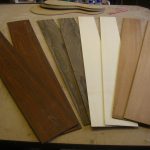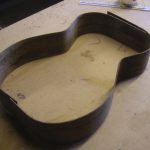…Side bending…….
- left to right: cocobolo, ziricote, maple and mahogany
- not yet trimmed to length
In a Nutshell
Most guitar shapes have only 3 bends to cope with. The lower bout, the waist, and the upper bout. All the bits in between are usually straight lines. There are only really two skills involved:
- finding where it needs bending
- bending
You will need: Your sides, a pattern, a bending iron clamped to your bench, and a container big enough to soak the sides in. I use a plant tray from a gardening centre. You could stick them in the bath if nobody minds.
Preparing the sides for bending
The sides should be thicknessed to .090″ (about 2.3 mm) and cut to size. They are then marked at the end where they will join at the back of the body (where the strap stud will eventually be).Try it all ways to find the best match. Also make a mark on the edge that will glue down to the soundboard. This is to avoid making two left sides….it has happened. Then the wood is soaked in water for 10-20 mins before bending.
There are 3 methods commonly used to bend the sides
Which method you use would normally depend on how many you want to make.
How to bend the sides by hand:
Start with the lower bout – this is the easiest as the curve is not too tight. Leave a small flat section for the tail block and start the curve. Rock the side back and forward over the bending iron and apply pressure till you feel it start to bend. Make a short hop sliding the side forward and keeping the pressure on to increase the length of the bend. Continue like this and you should see the bend start to emerge.
You will have to decide if you are over bending or underbending or if you are just right and adjust your technique to suit. Shorter hops and more heat make a tighter curve. Compare your side to the pattern to check how you are getting on.
You can straighten out an overbend by heating and applying pressure the other way. Try to avoid kinks.
It takes a while to get the hang of it so you should practice on scrap before mangling an expensive piece of tonewood.
Do all 3 bends roughly first then go over them again to further refine them. You can touch them up dry before assembling the guitar.
Using a mould
You could decide to make a mould which makes life slightly easier or if you are making more than one.
Roughly bend by hand until you can fit them into the mould, dampen them and then apply heat all the way round using the bending iron or a heat lamp, and clamp into position. When left to cool, preferably overnight, the sides take up the shape of the mould. They may spring back slightly when removed but you can always touch them up before assembly.
Fox side bender
You should know about these even if you don’t intend to use one. They cost money but save time and effort especially if you want to make a lot of guitars.


